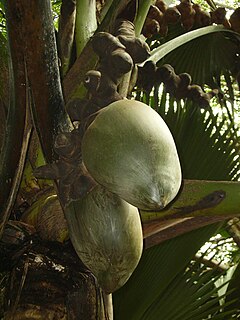
Lodoicea, commonly known as the sea coconut, coco de mer, or double coconut, is a monotypic genus in the palm family. The sole species, Lodoicea maldivica, is endemic to the islands of Praslin and Curieuse in the Seychelles. It has the biggest seed in a plant. It formerly also was found on the small islets of St Pierre, Chauve-Souris, and Ile Ronde, all located near Praslin, but had become extinct there for a time until recently reintroduced. The name of the genus, Lodoicea, may be derived from Lodoicus, one Latinised form of Louis, in honour of King Louis XV of France. Other sources say that Lodoicea is from Laodice, the daughter of Priam and Hecuba.

The lesser vasa parrot or black parrot is a black coloured parrot endemic to most of Madagascar. It is one of four species of vasa parrots, the others being the greater vasa parrot C. vasa, the Seychelles black parrot, and the Comoros black parrot. The latter two were formerly considered conspecific with the lesser vasa parrot.

Pisonia grandis, the grand devil's-claws, is a species of flowering tree in the Bougainvillea family, Nyctaginaceae.
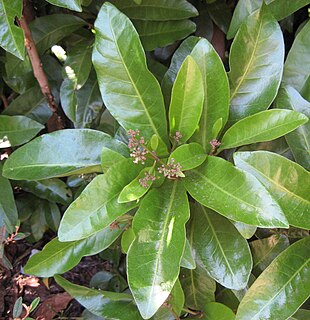
Pisonia is a genus of flowering plants in the four o'clock flower family, Nyctaginaceae. It was named for Dutch physician and naturalist Willem Piso (1611–1678). Certain species in this genus are known as catchbirdtrees, birdcatcher trees or birdlime trees because they catch birds. The sticky seeds are postulated to be an adaptation of some island species that ensures the dispersal of seeds between islands by attaching them to birds, and also allows the enriching of coralline sands. These island species include P. brunoniana of Australasia and Polynesia and P. umbellifera, which is widespread in the tropical Indo-Pacific region.

The Seychelles fody is a small yellowish songbird that are native to the Seychelles islands of Cousin Island, Cousine Island, Frégate Island, and have been introduced to Aride Island, D'Arros Island and as of 2004 Denis Island. Their natural habitat is woodland, but they have adapted to living in such habitats as coconut plantations and gardens.

The Seychelles fruit bat or Seychelles flying fox is a megabat found on the granitic islands of Seychelles, and on the Comoros and Mafia Island. It is a significant component of the ecosystems for the islands, dispersing the seeds of many tree species. Although it is hunted for meat on some islands, it remains abundant. It is particularly common on Silhouette Island.
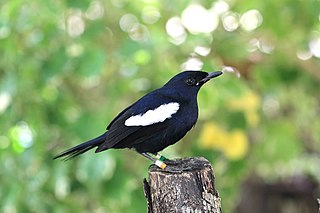
The Seychelles magpie-robin is a medium-sized endangered bird from the granitic Seychelles in the Indian Ocean.
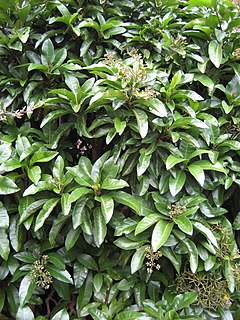
Pisonia brunoniana is a species of flowering tree in the family Nyctaginaceae that is native to New Zealand, Norfolk Island, Lord Howe Island and Hawaiʻi. The common names in New Zealand are parapara or birdcatcher tree.

Phoenicophorium, the thief palm, is a monotypic genus of flowering plant in the family Arecaceae. The sole species is Phoenicophorium borsigianum.
Erythroxylum sechellarum is a species of plant in the Erythroxylaceae family. It is endemic to Seychelles.
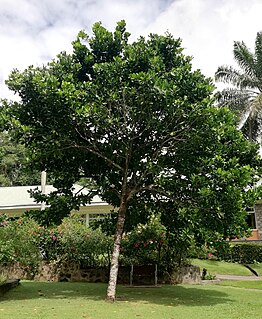
Mimusops sechellarum is a species of plant in the family Sapotaceae. It is endemic to Seychelles.

Pandanus balfourii, also known as Vakwa bordmer, is a species of plant in the family Pandanaceae, one of four Pandanus species that are endemic to the Seychelles.

Pandanus multispicatus is a species of plant in the family Pandanaceae, one of several Pandanus species that are endemic to the Seychelles.

Pandanus sechellarum is a species of plant in the family Pandanaceae. It is one of five species of Pandanus that are endemic to Seychelles.
Pisonia donnellsmithii is a species of plant in the family Nyctaginaceae. It is found in El Salvador and Guatemala. It is threatened by habitat loss.
Pisonia ekmani is a species of plant in the Nyctaginaceae family. It is endemic to Cuba.
Pisonia graciliscens is a species of plant in the Nyctaginaceae family. It is endemic to French Polynesia.
Pisonia siphonocarpa is a species of plant in the Nyctaginaceae family. It is endemic to French Polynesia.

Pisonia wagneriana, the pāpala kēpau or Kauaʻi catchbirdtree, is a species of flowering tree in the Bougainvillea family, Nyctaginaceae, that is endemic to Kauaʻi in the Hawaiian Islands. It is threatened by habitat loss.

Ceodes umbellifera, synonym Pisonia umbellifera, commonly known as the birdlime tree or bird catcher tree, is a species of plant in the Nyctaginaceae family. The evergreen shrub has soft wood, small pink or yellow flowers, and produces cavate brown fruit throoughout the period March to April. The species has been categorized under different genera in its documented lifetime, being reallocated between Pisonia and Ceodes. Its former genus, Pisonia, is named after a Dutch scientist, Willem Piso, and umbellifera is derived from Latin umbelliferum, denoting the species' big, 'shade-carrying' foliage.















